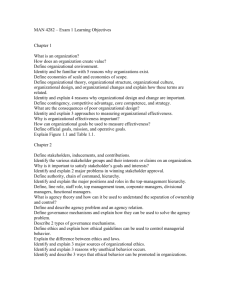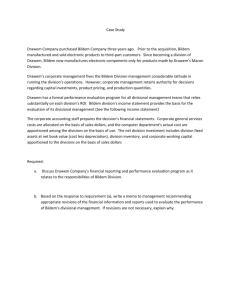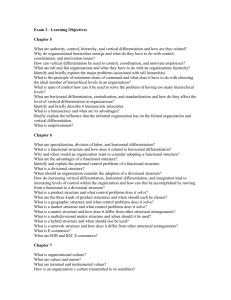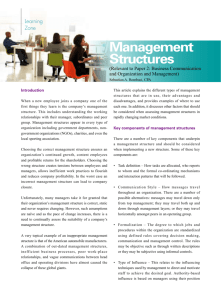File
advertisement
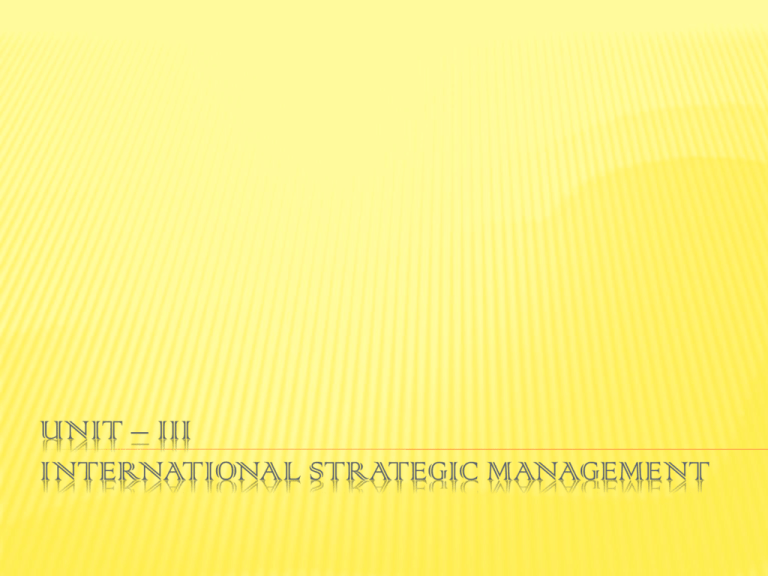
UNIT – III INTERNATIONAL STRATEGIC MANAGEMENT INTERNATIONAL STRATEGIC MANAGEMENT Strategy is derived from the Greek word ‘Strategos’ It means ‘Generalship – the actual direction of military force’ Strategy Mgt involves the analysis of internal capabilities and external environment of a firm in order to efficiently and effectively uses the resources to meet organizational objectives. FRAMEWORK FOR INTERNATIONAL STRATEGIC MANAGEMENT International Strategic Management - Overview External / Internal Analysis Strategic Choice and Positioning Leveraging Competitive Advantage Implementing the Strategic Plan Integration STRATEGIC COMPULSIONS Strategic management includes strategic planning, implementation, and review/control of the strategy of an organization. The companies want survive in the today’s business competition, they must sell their products in the global market and enlarge their market. The companies face the compulsion to be global if they want to gain the global market and more values. Ex: Sony, Pepsi, Microsoft… AREAS OF STRATEGIC COMPULSIONS Orientation for Globalization Emerging E-Commerce and Internet Culture Cut-Throat Competition Diversification Active pressure groups Motive for corporate social responsibility and ethics STANDARDIZATION VS DIFFERENTIATION Standardization or differentiation of the marketing strategy are two extremes of a continuum, i.e., as Differentiation increases Standardization decreases, Conversely as Differentiation decreases Standardization increases. Different aspects of Standardization vs differentiation Regional Perspective (Ex. EU, NAFTA, SAARC) Marketing Process Perspective Marketing Components / Marketing Mix Perspective (Ex. Google, Nokia, Microsoft) DIFFERENCE BETWEEN STANDARDIZATION VS DIFFERENTIATION Basis of Difference Standardization Differentiation Application in marketing means Companies should apply 4Ps in the Same way in World wide. It is supported by strong market variety by Market individualism and uniqueness. Reason for Application Integration Access Regional or local Conditions Product Offered Complete standardization Altering relevant feature according to individual or geographic Characteristics Doesn’t have special Characters Product is differential from competitors product. Approach Increasing Commonality of product Detailing the differentiation that exists between products and services Economics of scale Higher productivity and lowers the total cost Increasing cost of production and lower productivity Need Satisfy the heterogeneous needs of the buyer Satisfy a particular need of buyer End Result Benefits buyer by lowering price Show sense of value to the buyer STRATEGIC OPTIONS Strategic options are creative alternative action – oriented responses to the external situation that an organization (or group of organizations) faces. A Strategic option is a set of related options that form a potential strategy. INTEGRATION – RESPONSIVENESS GRID FACTORS AFFECTING STRATEGIC OPTIONS External Constraints Intra-Organizational forces and managerial power-relations Values and preferences and managerial attitudes towards risk Impact of past strategy Time constraints Information constraints Competitors reaction GLOBAL PORTFOLIO MANAGEMENT Global portfolio investment (Mgt) means a grouping of investment assets that focuses on securities from foreign markets rather than domestic market. Examples Purchase of shares Purchase of bonds issued by Foreign Govt. Acquisition of assets in Foreign Country FACTORS AFFECTING GLOBAL PORTFOLIO MANAGEMENT Tax rates on interest or dividends Interest rates Exchange rates GLOBAL ENTRY STRATEGIES FORMS OF INTERNATIONAL BUSINESS 1.Trade related forms of international business Exports – direct and indirect Indirect Exports Domestic Purchase Export Houses Piggybacking Trading companies FORMS OF INTERNATIONAL BUSINESS 2. Manufacturing Strategies without FDI International licensing International franchising International Contract manufacturing Turnkey Projects Management contracts FORMS OF INTERNATIONAL BUSINESS 3. Manufacturing Strategies with FDI Joint Ventures International strategic Alliance Merger & Acquisition Wholly owned subsidiaries ORGANIZATIONAL ISSUES OF I.B There are 3 issues First, the different elements of a firm’s organizational architecture must be internally consistent. Second, the organizational architecture must match or fit the strategy of the firm strategy and architecture must be, consistent. Third, the strategy and architecture must be consistent with competitive conditions prevailing in the firm’s market strategy , architecture and environment must be, consistent ORGANISATIONAL STUCTURE A Functional Structure A typical Product divisional Structure One company’s international divisional structure A world wide area structure A world Wide product Divisional Structure A FUNCTIONAL STRUCTURE Top Management Purchasing Buying Units Manufacturing Plants Marketing Finance Branch Accounting Sales Unit Units A TYPICAL PRODUCT DIVISIONAL STRUCTURE Head Quarters Product Line - Product A Line - B Product Line C Purchasing Buying units Manufacturing Plants Sales unit Marketing Finance Accounting Units COMPANY’S INTERNATIONAL DIVISIONAL STRUCTURE Head Quarters Domestic Division, product Domestic Division, product Domestic Division, product line - A line - A line - A Intl. Division G.M Area Line Country -1 Country – 2 G.M G.M Product A,B and C Product A,B and C A WORLD WIDE AREA STRUCTURE Head Quarters North Latin American American Area Area Middle European Area Eastern – African Area Far East Area A WORLD WIDE PRODUCT DIVISIONAL STRUCTURE Head Quarters WorldWide Worldwide Worldwide Product Division A Product Division B product Division C Area 1 Area 2 (Domestic) (International) A GLOBAL MATRIX STRUCTURE CONTROLLING OF INTRENATIONAL BUSINESS Personal Controls Bureaucratic Controls Output Controls Cultural Controls APPROACHES TO CONTROL Market approach Rules approach Corporate culture approach PERFORMANCE EVALUATION SYSTEM First, Incentive used often varies depending on the employees and their tasks Second, the successful execution of strategy in the multinational firm often requires significant cooperation between managers in different sub units CONTD… Third, the incentive system used within a multinational enterprise often have to be adjusted to account for national differences in institutions and culture Finally, it is important for managers to recognize that incentive systems can have unintented consequences. PROCESS OF PERFORMANCE MEASUREMENT Establish standards of performance Measure actual performance Compare actual with standards Construct and implement an action plan Review and revise standards OBJECTIVES OF PERFORMANCE EVALUATION To evaluate the economic performance of its international performance, this is frequently referred to as an evaluation of the unit’s management performance. To evaluate the unit’s management performance. To monitor progress towards corporate objectives including strategic goals. To assist efficient allocation of resources. THANK U
